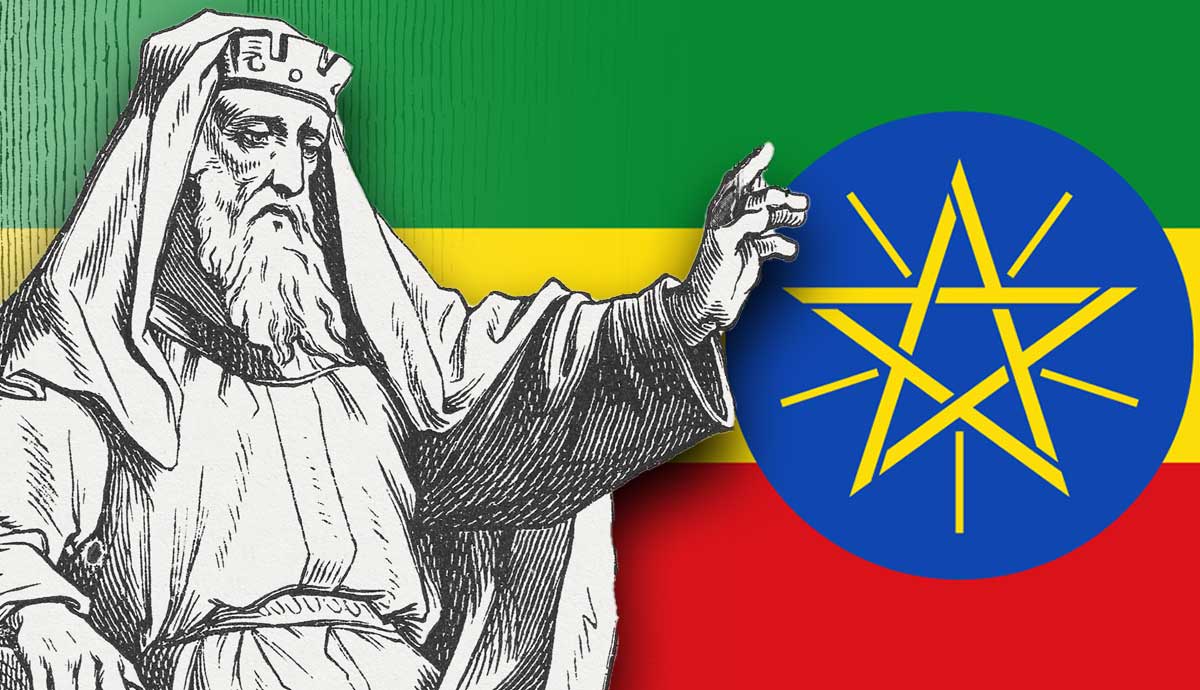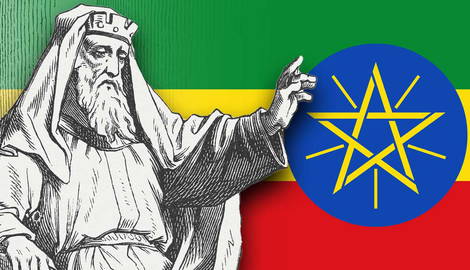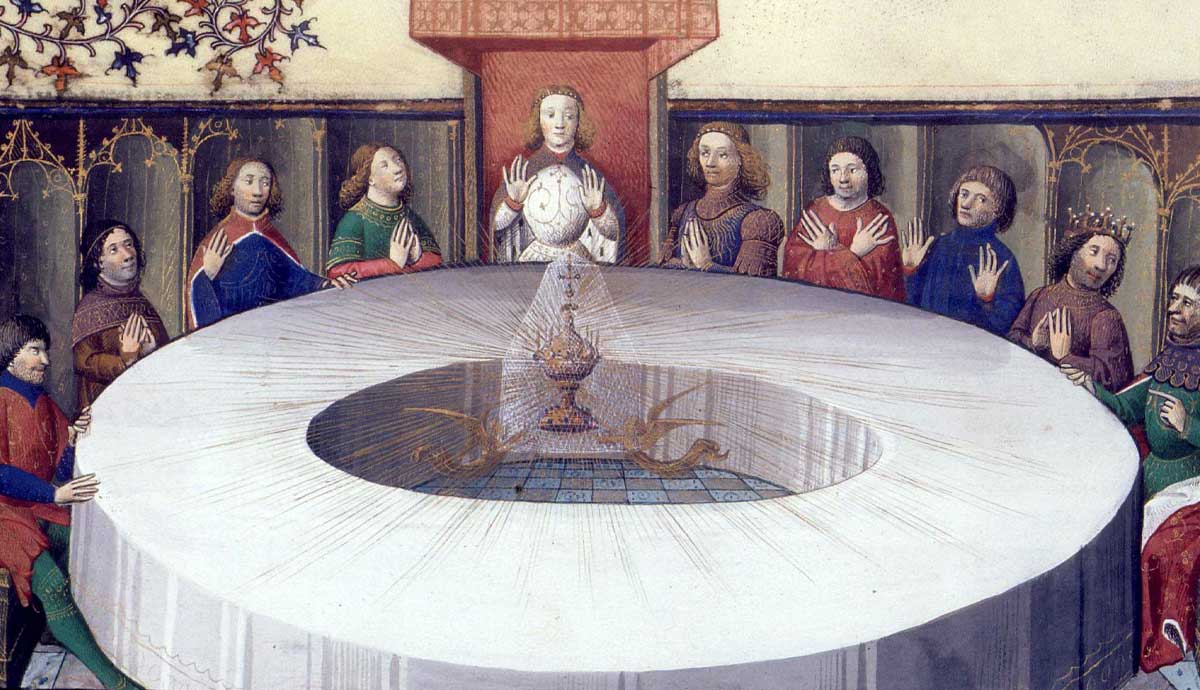
Upon converting to Christianity in the 4th century, Ethiopia’s rulers took their new religion and invested themselves with an entirely new national mythos. Dynasties traced their roots back as far as possible (and even beyond) in order to solidify their legitimacy. And where better to start than with the central text of Christianity, the Bible?
From the Kingdom of Aksum to Ethiopia’s final emperor, Haile Selassie, successive dynasties emphasized their Biblical ancestry—sometimes literally, others more symbolically. King Solomon and the Queen of Sheba were their progenitors, and their authority was blessed by God himself.
King Solomon: Setting the Scene

The Bible features many kings as central figures. Some are benevolent, like King David of Israel, and receive God’s blessing. Others, like Nebuchadnezzar II of Babylon or the Book of Exodus’s Egyptian Pharaoh, are evil. King Solomon is always depicted as a shining example of a ruler.
King Solomon, the son of King David, inherited the Israelite throne from his father. The Bible implies a power struggle at that time between Solomon and his brother, Adonijah. Solomon ultimately won the struggle but pardoned Adonijah. However, when Adonijah asked the new king if he could marry Abishag, his father’s young caregiver, Solomon reneged and sentenced his treacherous brother to death (1 Kings 2:20-25).

King Solomon’s reign was a prosperous one. He was righteous and faithful to God, and God blessed him in return.
God once asked Solomon what he desired most. The new king answered, “‘Give me wisdom and knowledge, that I may lead this people, for who is able to govern this great people of yours?’” (2 Chronicles 1:10). God was impressed by this request and threw in honor and wealth for good measure.
King Solomon was renowned from this point onward for his great, God-given wisdom. This is where our story goes south (literally). Word of Solomon’s wisdom came to reach another ruler: the Queen of Sheba. The queen made it her mission to witness Solomon’s knowledge for herself.
The Queen of Sheba’s Visit

The Queen of Sheba is an intriguing figure. In the entire Bible, she only appears twice, and these appearances are retellings of each other. Still, her episode will have enormous significance for our story ahead.
Having heard of King Solomon’s unmatched wisdom, the Queen of Sheba traveled north to Jerusalem with a grand retinue. She grilled Solomon with a series of questions and the king provided cogent answers. The Queen of Sheba was amazed, both by the depth of her host’s knowledge and the vast wealth of his city. “‘Praise be to the Lord your God,’ she exclaimed, “‘who has delighted in you and placed you on the throne of Israel’” (1 Kings 10:9).
The two rulers exchanged gifts: “King Solomon gave the Queen of Sheba all she desired and asked for…” (2 Chronicles 9:12). Then the queen left Jerusalem and returned home. This is where the story of King Solomon and the Queen of Sheba ends.
Or is it? Before we explore the story any further, let’s take a detour into the history of Ethiopia. After all, that is where our story culminates.
The Birth of Christianity in Ethiopia

By the 4th century CE, Christians had likely established a small presence in the Ethiopian highlands. At the time, this region was controlled by the wealthy Kingdom of Aksum. One Aksumite king, Ezana, would be regarded as the father of Ethiopian Christianity. It was under his rule that Ethiopia became the first Christian country in Africa, and the second in the world, after Armenia.
Aksum endured for 600 years. Their kings made conquests on both sides of the Red Sea and Aksum was known across the region as a trading center. Coins from the time period bear the Christian cross. After Aksum faded away, its successors, the Zagwe Dynasty, similarly emphasized a long Biblical history. Unfortunately, we don’t know much about the Zagwe Dynasty. If the Zagwe kings kept records, it is possible that they were destroyed over the ensuing centuries. Their conquerors, the so-called “House of Solomon,” are at the center of our story.
The Solomonic Dynasty’s Founding Myth

In 1270, a nobleman named Yekuno Amlak led an army to overthrow the Zagwe king. His campaign was successful and it inaugurated the Ethiopian Empire. The dynasty he founded, known to modern historians as the House of Solomon, supposedly ruled Ethiopia for the next 700 years.
How did Yekuno Amlak’s dynasty claim descent from King Solomon? One primary source, the Kebra Nagast, goes into detail about the new imperial family’s pedigree. It interprets the story of King Solomon and the Queen of Sheba to suggest something entirely new—that the queen and Solomon had a child together.

The Old Testament does not describe the Queen of Sheba in detail. She isn’t named, nor does the Bible say where “Sheba” was located. Some scholars have identified Sheba with Saba (in modern Yemen), but no consensus has been reached.
Ethiopian tradition fills in these gaps: the Queen of Sheba is named Makeda, and her kingdom was in Ethiopia itself. The verse from 2 Chronicles regarding how “King Solomon gave the Queen of Sheba all she desired and asked for” takes on a new meaning as well. The Ethiopian Orthodox Church interprets this verse sexually; not only did Solomon give the queen treasures, but they also produced a son, named Menelik.
According to the Kebra Nagast, Menelik would become Ethiopia’s first king. The legend even states that he went to visit his father as a young adult. Someone in his retinue stole the Ark of the Covenant from Jerusalem and brought it back to Ethiopia. The relocation of the Ark illustrates the Ethiopian view that God’s chosen land had moved from ancient Israel to Ethiopia.
How Factual Is the Solomonic Legend?

Just how much of the Kebra Nagast is factual? To modern academics, most of the details are not possible to verify. The Kebra Nagast was compiled in the early 14th century but may have had roots in older sources. No one has positively identified Menelik, the supposed son of King Solomon and the Queen of Sheba. So at least a significant chunk of the Kebra Nagast seems to be legend.
Many Ethiopians believe that the Solomonic narrative is true—especially the story of the Ark of the Covenant. Today, the Ethiopian Orthodox Church still contends that the major cathedral in the town of Aksum houses the Ark. All other Ethiopian Orthodox churches house a replica of the Ark, known as a tabot. The Church hierarchy has not allowed outside observers in to verify their claim, but the story remains a powerful one.
Did the Solomonic Legend Change Over Time?

According to the traditional narrative, the House of Solomon ruled Ethiopia from Yekuno Amlak’s seizure of power in 1270 until the military coup of 1974. Ethiopian emperors asserted that their right to rule was a product of divine providence and their blessed ancestors, King Solomon and the Queen of Sheba. This would make the Ethiopian imperial family one of the oldest dynasties on Earth.
Ethiopian history, however, might not back up this narrative. Historian Sara Marzagora believes that Solomonic heritage may have been conceptualized in different ways over time. She writes that at some points, the Kebra Nagast does not appear to have been more important than other sources. The requirements for being a good ruler weren’t solely based on descent from King Solomon, either. A ruler’s experience leading military campaigns and just being an Orthodox Christian might have carried even more weight.

The problem of imperial succession complicates things, too. Ethiopian tradition upheld a dynastic plan but the oldest son of an emperor would not necessarily gain the throne. Succession disputes between brothers, fathers, uncles, and sons occurred throughout the Medieval Period. Between the 1770s and 1850s, local warlords were more powerful than the emperor himself. And noble intermarrying meant that a single, unbroken “House of Solomon” probably didn’t exist. A genealogical link to King Solomon may have been more symbolic than literal.
Ethiopia’s later emperors took the Solomonic myth literally. Faced with Italian imperialism, Emperor Menelik II (r. 1889-1913) justified his rule based on the Old Testament narratives. Haile Selassie, Ethiopia’s final monarch, emphasized this as well in Ethiopia’s 1955 constitution. The idea that Ethiopia’s divinely ordained monarchy was very ancient mirrored contemporary propaganda in pre-war Japan.
Ethiopian history would undergo a seismic shift in the 1970s. A major student movement and a military coup by communist officers violently forced Haile Selassie from power in September 1974. The Solomonic line was finished.
Conclusion: Ethiopia’s King Solomon Connection

For 700 years, Ethiopian monarchs used Solomonic heritage (whether symbolic or literal) to buttress their claims to the throne. Given elite intermingling and repeated succession crises, a single, united family did not retain control for the entire period. Still, the idea of descent from King Solomon was remarkably durable in pre-modern Ethiopia. An emperor’s claim of descent from King Solomon and the Queen of Sheba was an important element in securing his political legitimacy.
Bibliography
1 Kings (New International Version).
2 Chronicles (New International Version).
Grief, Isaac Toman. “Solomonic Descent in Ethiopian History.” World History Encyclopedia. November 18, 2021. https://www.worldhistory.org/article/1875/solomonic-descent-in-ethiopian-history/.
Marzagora, Sara. “Refashioning the Ethiopian Monarchy in the Twentieth Century: An Intellectual History.” Global Intellectual History 7, no. 3 (2020): 533-557. Accessed October 29, 2024. https://doi.org/10.1080/23801883.2020.1796237.










